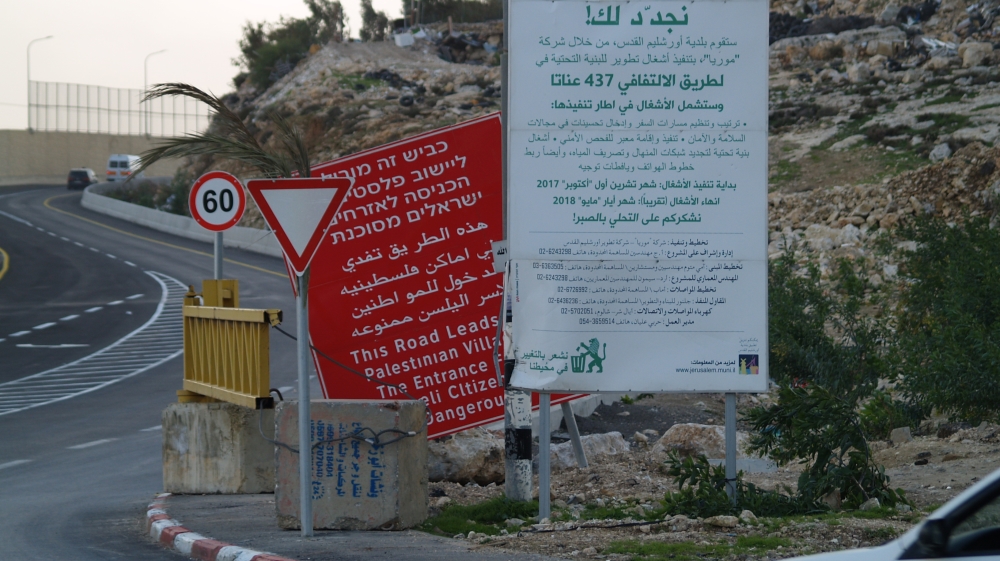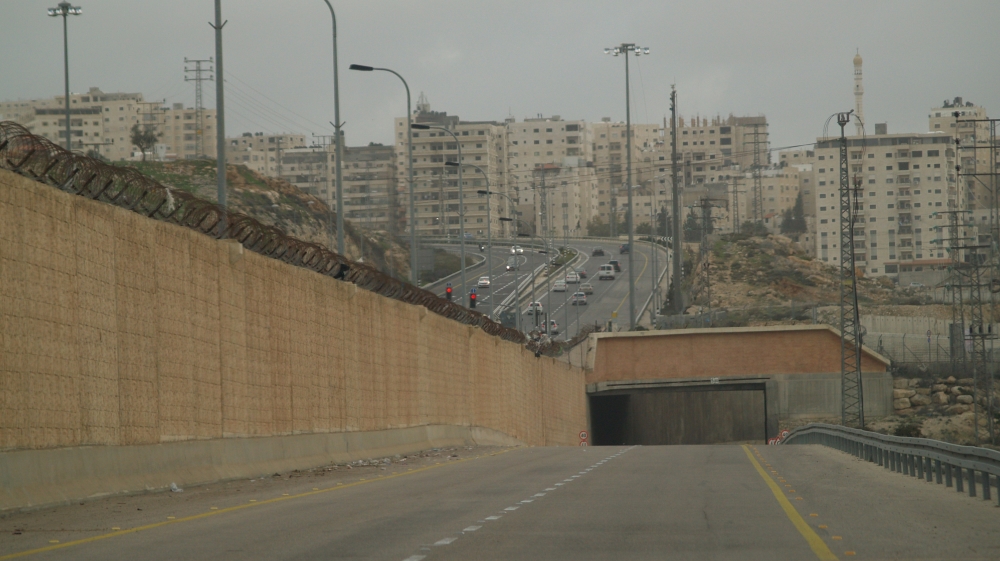
Anata, occupied West Bank – A newly-opened highway in the occupied West Bank has been hailed by Israelis but condemned by Palestinians, who are calling it “Apartheid Road”.
It’s the first operational section of an eastern ring road around Jerusalem that could deny Palestinians access to parts of the West Bank and threaten a future Palestinian state.
Route 4370 has a high wall in the middle, topped with fencing that segregates the road into two separate two-way lanes.
The western side is for Palestinians in the West Bank to use to go around Jerusalem, which they cannot enter without an Israeli military-issued permit, while the eastern side serves Israeli settlers going to and from Jerusalem.
Palestinians from the village of Anata, which lies on the outskirts of Jerusalem but is separated from the city by Israel’s barrier wall, say part of the highway is built on Anata’s land.
‘They want to take that land’
“Anyone can see the Israelis’ plan,” said resident Ahmed Rifea. “A few months ago they wanted to take Khan al-Ahmar,” Khan al-Ahmar is the Bedouin village that garnered international attention after the Israeli government issued a demolition order against it. “Now they build this new road? They want to take that land,” Rifea said.
Originally encompassing 35,000 square-kilometres of land, Anata has shrunk to a little more than 1,000 square-km because more than 90 percent of it lies in Area C as agreed by the Oslo Accords, putting it under total Israeli civil and security control.
The Rifea family owns hundreds of dunams (tens of hectares) of land in Anata, but almost all of it has been confiscated by Israel for road and illegal Jewish settlement construction.
 |
| The road has red ‘dangerous for Israelis to enter’ signs that signal a Palestinian-only route [Megan Giovannetti/Al Jazeera] |
E-1 and ‘Greater Jerusalem’
Route 4370 runs northeast of Jerusalem past Khan al-Ahmar and the illegal Jewish settlement of Maale Adumim – in a controversial area known as E-1, which lies on the eastern outskirts of Jerusalem.
Israeli authorities want to annex E-1 as part of their “Greater Jerusalem” plan to redraw the borders of the city – Khan al-Ahmar stands in the way, which may be why Israel ordered it demolished.
Expanding Jerusalem further east would create room for more settlement growth, connect Maale Adumim to the city as a suburb and ease the housing crisis for Jewish Israelis in Jerusalem.
The annexation of E-1 would also displace about 140,000 Palestinians living in East Jerusalem towns and villages, like Anata.
Moreover, it would continue Israel’s fragmentation of the West Bank by bisecting the northern Palestinian cities from the south, making any potential future state of Palestine less viable.
A ‘gift’ from Israel
According to the Coordinator of Government Activities in the Territories (COGAT) spokesperson’s office, “The construction of the new road was intended to shorten and optimise travel times for Palestinian residents of Judea and Samaria,” – using the biblical name for the West Bank.
Israel Afrayat, transportation coordinator for the Israeli civil administration, appeared in a promotional video explaining the purpose of the new road and why Israel has “gifted” it to the Palestinians.
The road is meant to “serve all people”, Afrayat said in the video, which is published on the Arabic language Facebook page of COGAT.
“Our goal is safety first – to protect your children,” Afrayat said.
Representatives in both the Palestinian Ministry of Public Works and Housing and the Ministry of Transportation said they were not notified and had no information about the opening of the new road.
 |
| The old road offered Palestineans access to Jerusalem [Megan Giovannetti/Al Jazeera] |
“The main purpose of this road is to connect Maale Adumim with Jerusalem and to separate Palestinians from their land, especially people from Anata,” Jihad Shobaki, an officer at the Palestinian Ministry of Public Works and Housing, told Al Jazeera.
Israeli activist group Ir Amim agreed and said the highway “eliminates one of the obstacles to settlement construction in E-1 and should signal cause for heightened vigilance”.
According to Ir Amim, the northernmost part of “Apartheid Road” was always intended to “solve” the dilemma of maintaining at least transportation contiguity between northern Palestinians cities and the south while diverting them from the E-1 and Jerusalem areas.
The highway was initially conceived more than a decade ago by late Israeli Prime Minister Ariel Sharon. International pressure delayed construction for years.
Rifea said he found out about the road being opened through the COGAT Facebook page. Other Anata residents learned through the notice distributed to them by COGAT stating that it is forbidden to build on their own land within 300 metres of the new road.
“If they close the road, they shut off people from their land. As always, when Israelis open one thing, they close another,” Shobaki said.
“In the end, we will use [the road]. What can we do?” Rifea said.
 |
| The Anata-Azzayim road became the first operational section of the Eastern Ring Road in the West Bank – also known as ‘Apartheid Road’ [Megan Giovannetti/Al Jazeera] |












